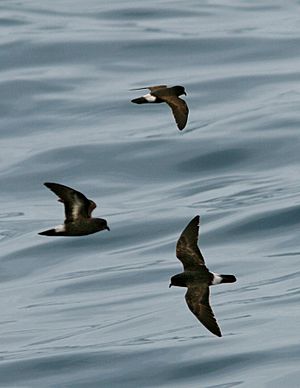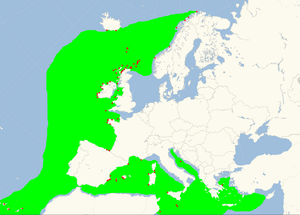European storm petrel facts for kids
The European storm petrel is a tiny seabird. It's also called the British storm petrel or just storm petrel. Its scientific name is Hydrobates pelagicus. This little bird lives in the Atlantic Ocean and the Mediterranean Sea. You can find it near the coasts of Europe.
Quick facts for kids European storm petrel |
|
|---|---|
 |
|
| Conservation status | |
| Scientific classification | |
| Genus: |
Hydrobates
|
| Species: |
pelagicus
|
| Subspecies | |
|
H. p. pelagicus (Linnaeus, 1758) |
|
 |
|
| European and Mediterranean range of H. pelagicus (Full range extends into the South Atlantic Ocean) Known or probable breeding colonies At-sea range in Northern Hemisphere summer |
|
| Synonyms | |
|
|
Contents
What is a European Storm Petrel?
European storm petrels are very small seabirds. They spend almost their entire lives out at sea. These birds only come to shore when it's time to breed. They gather in large groups called colonies to lay their eggs.
How Big Are They?
The European storm petrel is one of the smallest seabirds. It is about 16 centimetres (6.3 in) long. Its wings can spread about 37 centimetres (15 in) wide. This tiny bird weighs around 27 grams (0.95 oz). That's about the same as a few quarters!
What Do They Look Like?
These birds are mostly black. They have a clear white patch on their body. This makes them easy to spot against the dark ocean.
Where Do European Storm Petrels Live?
These birds live in the Atlantic Ocean and the Mediterranean Sea. They are often found near the coasts of Europe.
Where Do They Breed?
The biggest known breeding colony is on Nólsoy. This island is part of the Faroe Islands. You can mainly find these birds in the ocean between Iceland, the Lofoten islands, and the Faroe Islands. Sometimes, they can also be seen near the coasts of Belgium, the Netherlands, and Schleswig-Holstein in Germany.
How Do They Find Their Way?
Storm petrels have a very good sense of smell. They use this amazing sense to find their way. They can find their nest even at night. They also use their sense of smell to find food in the dark.
Images for kids
-
Old illustrations, such as this one by John Gould, showed petrels in unusual standing positions.
-
Ringing a storm petrel at Cape Wrath.
-
The by-the-wind sailor is a small jellyfish eaten by storm petrels.
-
Mother Carey. An illustration by Howard Pyle from 1902.
See also
 In Spanish: Paíño europeo para niños
In Spanish: Paíño europeo para niños









